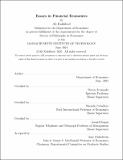| dc.description.abstract | This thesis contains four chapters on liquidity, financial crisis, dynamic pricing and optimal contracting with externalities.
The first chapter studies how transparency (information disclosure), along with long term incentive of informed dealers, affect price informativeness (efficiency), market liquidity and welfare in dynamic over the counter (OTC) markets. We show more transparency, via the public disclosure of additional information about past trades, paradoxically, makes the markets more opaque, by reducing market price informativeness. However, this market opacity creates liquidity and improves welfare. Our policy implications are threefold: (i) forwardlooking incentive of informed dealers reduces price efficiency but improves liquidity; (ii) the post-trade public disclosure of prices may have no impact on price efficiency and liquidity; (iii) however, the public disclosure of past transaction orders or volumes reduces price efficiency but improves liquidity. We also derive several testable implications about price efficiency and market liquidity and demonstrate the robustness of our findings in face of a general class of payoff functions, stochastic trading positions, divisible and indivisible orders, finite and infinite trading calendars, and fixed or time-varying fundamentals.
In the second chapter we propose an amplification mechanism of financial crises based on the information choice of investors. Information acquisition always makes investors more likely to act against what is suggested by the prior. Deteriorating public news under an initially strong (weak) prior increases (reduces) the value of private information and induces more (less) information acquisition. Deteriorating public news always increases the probability of a crisis, since the initially strong (weak) prior suggests do-not-attack (attack). This effect is amplified when information choices are endogenous. To enhance financial stability, a policymaker can use taxes and subsidies to affect information acquisition. We also derive testable implications for the magnitude of amplification. This chapter is published in the Review of Financial Studies (RFS), vol 30.
In the third chapter we study the problem of optimal dynamic pricing for a monopolist selling a product to consumers in a social network. In the proposed model, the only means of spread of information about the product is via Word of Mouth communication; consumers’ knowledge of the product is only through friends who already know about the product’s existence. Both buyers and non-buyers contribute to information diffusion while buyers are more likely to get engaged. By analyzing the structure of the underlying endogenous process, we show that the 3 optimal dynamic pricing policy for durable products with zero or negligible marginal cost, drops the price to zero infinitely often. By attracting low-valuation agents with free-offers and getting them more engaged in the spread, the firm can reach out to potential highvaluation consumers in parts of the network that would otherwise remain untouched without the price drops. We provide evidence for this behavior from smartphone app market, where price histories indicate frequent free-offerings. Moreover, we show that despite infinitely often drops of the price to zero, the optimal price trajectory does not get trapped near zero. We demonstrate the validity of our results in face of strategic forward-looking agents, homophilybased engagement in word of mouth, network externalities, and consumer inattention to price changes. We further unravel the key role of the product type in the drops by showing that the price fluctuations disappear after a finite time for a nondurable product. This chapter is published in the Management Science (MS), vol 64.
Finally, in the last chapter we study optimal contracting between a firm selling a divisible good that exhibits positive externality and a group of agents in a social network. The extent of externality that each agent receives from the consumption of neighboring agents is privately held and is unknown to the firm. By explicitly characterizing the optimal multilateral contract, we demonstrate how inefficiency in an agent’s trade propagates through the network and creates unequal and network-dependent downward distortion in other agents’ trades. Furthermore, we describe bilateral contracts (non-linear pricing schemes) and characterize their explicit dependence on the network structure. We show that the firm will benefit from uncertainty in an agent’s valuation of other agents’ externality. We describe the profit gap between multilateral and bilateral contracts and analyze the consequences of the explicit dependence of the contracts on network structure. When the network is balanced in terms of homogeneity of agents’ influence, network structure has no impact on the firm’s profit for bilateral contracts. On the other hand, when the influences are heterogeneous with high dispersion (as in core-periphery networks) the restriction to bilateral contracts can result in profit losses that grow unbounded with the size of networks. This chapter is published in the Journal of Economic Theory (JET), vol 183.
JEL Classification: G1, G2, G3 | |
